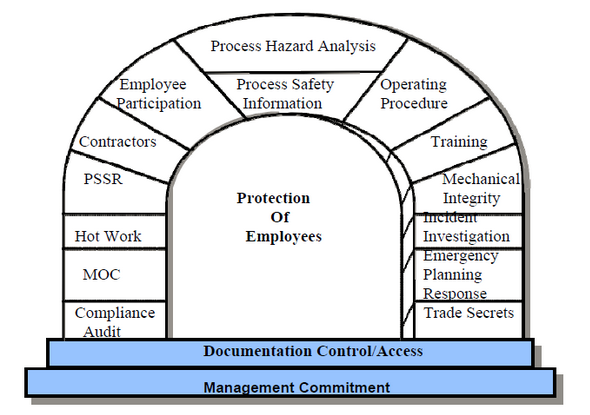Process safety management (PSM) is a safety regulation put into place by OSHA to help prevent the release of any substance deemed “highly hazardous” by the EPA or OSHA.
PSM programs include organization and operation processes, guidance and prevention, audit programs, and process safety management training of employees.
Today we are going to look at some of the key elements you must include in your company’s PSM program, so that you can maintain safety compliance going into 2018.
The 14 PSM Elements
OSHA defines 14 specific elements that must be included in all process safety management programs.
1. Employee Participation
All employees must be involved in every aspect of your PSM program. And, since OSHA requires written employee participation, it is best you create a formal plan for safety meetings.
2. Process Safety Information
Employees should be able to access and understand the technical information related to any highly hazardous chemicals (HHC) they work with on the job.
3. Process Hazard Analysis
Engineers and maintenance leaders must know the health and environmental consequences should a safety precaution fail, and an HHC release occur.
4. Operating Procedures
There must be a plan in place for any kind of situation that may arise concerning a potential chemical release. This includes emergency shutdowns and plans to get to safety.
5. Training
Project safety management training is required for all workers carrying out processes involving HHC. This training must be documented and easily accessible.
6. Contractors
Any contractors your company coordinates with must also understand the hazards they may face while working with you or entering a job site. This might include potential fire, explosion, or toxic release hazards.
7. Pre-Startup Safety Review
Whenever a work site shuts down, and subsequently starts back up, you must review with your employees everything learned in PSM training, and notify workers of any changes.
8. Mechanical Integrity
Documented inspections of pressure vessels, storage tanks, piping systems, and ventilation systems are required by OSHA and can only be performed by certified professionals.
9. Hot Work Permits
Any employee or contractor that performs welding or other high temperature work near covered processes must hold the proper permits.
10. Management of Change
Changes to the existing process procedures regarding chemicals, technology, and equipment must be well-documented and shared with all employees.
11. Incident Investigation
OSHA has standards in place for investigations that occur after any situation that resulted in – or could have resulted in – an HHC release on a job site.
12. Emergency Planning and Response
Emergency plans, even for the smallest chemical releases, must be in place. In addition, all employees should know their role when it comes to emergency procedures.
13. Compliance Audits
All companies inspected for PSM program compliance must keep the two most recent audits. They also need to verify every three years that their practices are compliant with current OSHA standards.
14. Trade Secrets
All processes that may affect the health and safety of employees must be disclosed, regardless of the desire to protect company “trade secrets”.
As you can see, OSHA has gone to great lengths to protect people working with HHC. They also seek to ensure employers follow their strict procedures to reduce the number of workplace injuries resulting from HHC releases.




